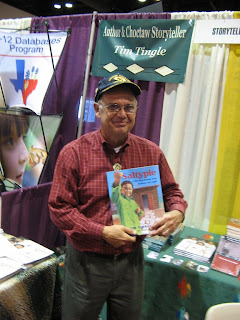Update on Sep 30 2023: I (Debbie Reese) no longer recommend Bruchac's work. For details see Is Joseph Bruchac truly Abenaki?
Joe, however, was able to get rights to it, and he's bringing it out through his own press, Bowman Books. It'll have a new cover and he's worked on a better presentation of the form that appears on page 112-113 of the hardcover edition with the tree on the front. (Update, September 19, 2010: This is on hold for now...)
Those of you who have not read the book may not know what form I'm talking about. I'm not worried about spoilers here. I'm much more interested in telling you about the book and why you should order it as soon as its ready (I'll let you know as soon as I get the word from Joe.)
The form says (for ease of sharing it below, I'm leaving out the lines on the page that say "Strike out inappropriate words"):
We, Harmon P. Wilcox and Frederick Daniels Murtaugh, physicians and surgeons legally qualified to practice inthe State of Vermont, hereby certify that on the 12th day of March 1932, we examined Sophia Lester, a resident of Highgate, Vermont, and decided:
(1). That she is an idiot feebleminded insane person and likely to procreate imbecile feebleminded insane persons if not sexually sterilized.
(2). That the health and physical condition of such person will not be injured by the operation of vasectomy salpingectomy;
(3). That the welfare of such person and the public will be improved if such person is sterilized;
(4). That such person is not of sufficient intelligence to understand that she cannot beget children after such operation is performed.
Signed in duplicate this 12th day of March, 1932,
Harmon P. Wilcox
Frederick Daniels Murtaugh
The book is set in 1954 in New York. When the story begins, Sonny doesn't know that he's Abenaki. He's growing up like other kids. By that I mean he watches cowboy and Indian films at the theater and picks up a lot of stereotypical information about Indians. His mother has taught him to sleep lightly, lest someone sneak up on him. Ironically, he imagines Indians sneaking up on him.
I was telling someone about these eugenics programs a few days ago, and he didn't know about them. I'm quite certain very few Americans know about it either.
In his Author's Note, Bruchac writes that Vermont was one of thirty-one states in the United States that enacted legislation to sterilize the "feeble-minded." The note also says that Abenaki's weren't the sole
Hidden Roots is a very important book and I look forward to it being back in print.
__________________________
Further information:
There are several research articles coming out of American Indian Studies about the sterilization of Native women that took place as late as the 1970s.
"The Lost Generation: American Indian women and sterilization abuse" by Myla Vicenti Carpio was published in 2004 in Social Justice. It is available, in full, online here. Take time to read her entire article.
"The Sterilization of Native American Women" by Jane Lawrence, published in American Indian Quarterly in 2000. The first two paragraphs describe the experiences of a woman and her husband, and, two fifteen year old girls who went into the hospital for appendectomies and follows that with an overview of the Indian Health Service and its development over time. Because Native women began to come forward saying they had been sterilized, the Government Accounting Office conducted an investigation and found that
IHS performed twenty-three sterilizations on women under the age of twenty-one between July 1, 1973 and April 30, 1974, and thirteen more between April 30, 1974 and March 30, 1976. The doctors at the IHS hospitals didn't understand the regulations, and, the doctors under contract for IHS weren't required to follow the regulations.
In "The Continuing Struggle Against Genocide: Indigenous Women's Reproductive Rights," D. Marie Ralstin-Lewis writes that Congress authorized sterilization of the poor in 1970 through the Family Planning Act. In 1974, she writes that the Department of Health, Education, and Welfare (HEW):
circulated pamphlets among Indian communities extolling the benefits of sterilization. One, called "Plan Your Family," contains a cartoon depiction of Indians "before" and "after" sterilization. The Indians before sterilization appear sad and downtrodden. The couple has ten little Indian children and only one horse, implying they are poor because they have too many mouths to feed. In contrast, the Indian couple in the "after" picture is happy; they have one child and many [ten] horses."








